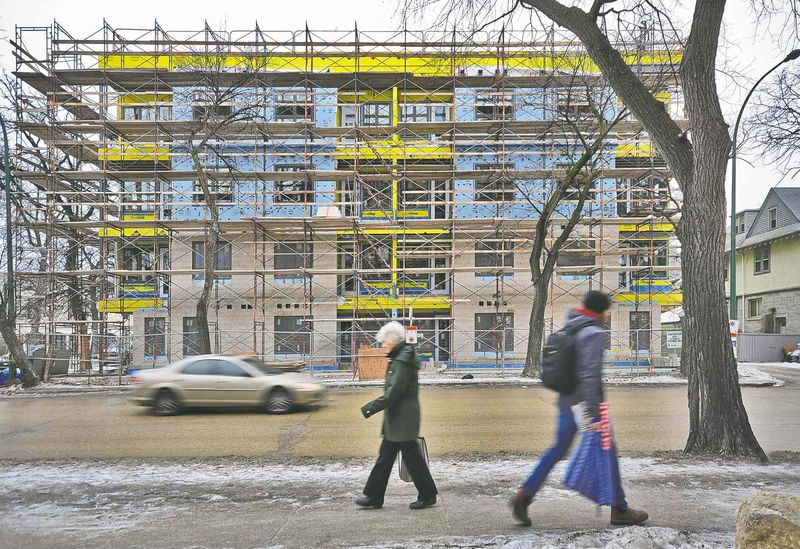By Brent Bellamy, Creative Director and Architect


Every young intern architect in the country has been through the experience of having their eyes glaze over when first trying to solve the Rubik's Cube puzzle known as the National Building Code of Canada. For those in Manitoba, that challenge just became much more difficult.
This month, the province became one of the first in Canada to adopt the National Energy Code for Buildings. The target of these new regulations is to increase the average energy efficiency of new construction by 25 per cent and to reduce levels of greenhouse gas emissions by 450,000 tonnes, equivalent to removing 90,000 vehicles from Manitoba's roads during the next 20 years.
Until now, environmental sustainability has largely been a voluntary initiative, championed by idealistic designers and building owners. Adopting the energy code is a first step to establishing the principles of green building design as mandatory construction requirements. The new code sets a baseline for building energy performance and outlines three methods designers can use to comply.
The first route is called the Prescriptive Path, which provides a checklist of stringent demands that must be met. These include such things as increased insulation values and restrictions on window areas to a maximum of 29 per cent of overall exterior walls. The second method, called the Tradeoff Path, allows designers to substitute higher-performing features to reduce the energy-efficiency requirements of others. As an example, to allow a wall to be more than 29 per cent glass, the increase in area can be traded for a more efficient heating system, as long as the baseline energy levels are still met. The third method of compliance is the most flexible, but also the most complex. Called the Performance Path, designs must demonstrate overall energy efficiency by using detailed computer-model simulations that track hourly performance.
A key change to the code is how insulation values will be measured. The 'effective' or real-world performance of the complete wall or roof system is now the benchmark, where in the past they were rated by the thickness of insulation only. If a value of R20 insulation was put between the studs of a wall, it was considered to be an R20 wall, even though the heat loss through the studs significantly reduces its performance. Testing of conventional commercial wall construction with exterior rigid insulation is finding those previous R20 walls were performing to as little as R7. Achieving the new requirements of a true R27 will not simply mean the addition of slightly more insulation; it may require a re-examination of traditional construction methods.
Because buildings consume 70 per cent of Canada's electricity and emit 35 per cent of the country's greenhouse gases, improved energy efficiency is a necessary component of any long-term strategy to address climate change and reduce our carbon footprint. In the short term however, the new regulations may affect the already challenging economics of development in Winnipeg.
Of the major cities in Canada, Winnipeg has the highest costs of construction, caused by clay soil that demands strengthened foundation systems, an extreme climate requiring more careful construction techniques, a shortage of skilled tradespeople and a lack of competitive bidding for contractors and material suppliers.
The challenge of high capital costs for developers is compounded by the fact that on the payback side, Winnipeg also has some of the lowest residential, hotel and office rental rates in the country. These competing factors strain the economic case for investment in new buildings.
A further increase in construction costs created by the requirements of the new energy code will only widen this economic disparity for some types of development. Less affected will be large projects with owner/tenants such as schools, hospitals, government buildings and other institutions. Developers of these building types will realize some long-term payback through lower energy bills and will more easily absorb the increased initial construction costs. As higher-budget projects, they will be able to invest in computer energy modelling and may afford higher-performing systems that can be traded off to solve some of the complexities of construction.
Privately developed tenant buildings such as office, retail and in particular multi-family housing, will be challenged to affordably meet the requirements of the new code.
With utility costs typically paid by the tenant, developers will not benefit from the improved energy efficiency. Capital cost is the driver of these developments, and they are often built on razor-thin margins, their viability affected by every incremental increase in costs.
To make the economics work, these expenses will likely be passed on to tenants through lower-quality building finishes and higher rents or condominium prices. This could make new construction even less competitive against existing or renovated properties. A slower uptake in sales and an increase in initial and financing costs would make it less appealing as an investment opportunity. Tenants may be persuaded to pay higher rents because of lower utility bills, but with Manitoba having the lowest electrical rates in Canada, the payback timeline is often too long to be fully realized.
To rebalance the equation and be competitive in the existing market, developers may look for opportunities to reduce costs that negatively affect the environment by accelerating urban sprawl and decelerating higher density growth. More complex infill projects, vital to adding density to existing neighbourhoods, may become less attractive as builders increasingly seek the lower construction costs of unrestricted open sites at the suburban fringes. Developers might look to avoid the effects of the new energy code altogether by moving toward lower-density, smaller wood-frame projects that are currently not under its umbrella.
Restrictions on window sizes prescribed in the new regulations might affect the physical quality of smaller living spaces, and when coupled with the disincentive of increased rents, higher-density urban living may become even less appealing to the Winnipeg market than it is currently. All of these factors could work together to reduce the number of larger residential projects that play a key role in providing affordable housing and making the city more compact and more sustainable in the long term.
It is vital we begin taking concrete steps to reducing our carbon footprint and addressing climate change. More comprehensive energy requirements for buildings will be beneficial in the future, but with Winnipeg's unique conditions of an extreme climate, high construction costs, low energy costs and low rental and purchase rates, the path to greater energy efficiency may in the short term increase the already significant challenges to new development in our city and our province.
Brent Bellamy is senior design architect for Number Ten Architectural Group.
Republished from the Winnipeg Free Press print edition December 29, 2014 B6